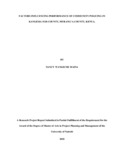| dc.description.abstract | The government of Kenya rolled out community policing initiative as an alternative to fighting crime and disorder since the traditional policing approach has not worked on the same. The policing practices that worked in the past are being invalidated by the changing characteristics of crime and social disorder. These shifts necessitate the practice of community policing to control and manage crime efficiently. The success of community policing depends on effective implementation, thus factors influencing the performance of community policing are of importance in this study. The study aimed at achieving four objectives which included; to determine whether training of community policing members affect community policing; to investigate whether community policing policies influence community policing; to assess whether funding influence community policing; to investigate whether police-community relations influence community policing. The study was limited by time, availability of resources, and fear of victimization by respondents. To mitigate the challenges, the researcher prepared comprehensive open and close ended questionnaires. The study was narrowed down to Kangema Sub County and not the entire Murangá County. Lastly the researcher assured the respondents of confidentiality of the information they were to give. The study was based on the assumptions that all the independent variables remained constant during the whole period of the study and that respondents gave correct information. The study employed a descriptive research design. The target population was 449 comprising active community policing committee members, National Government Administration officers and members of the National Police Service. A sample of 45 respondents was selected through stratified random sampling and purposeful sampling methods. The study used questionnaires as research instruments to collect data. Data collected from questionnaires was edited, coded and analyzed using descriptive and inferential statistics with the help of the SPSS program. Inferential statistics used frequencies and percentages while descriptive statistics used Spearman’s correlation coefficient and hypothesis testing was done by use of Chi Square test.The results of analysis were presented through tables and figures besides the computed percentages and frequencies to enhance the understanding of the study findings. The study found out that crimes in Kangema Sub County were still prevalent because community policing members were not performing their roles effectively due to inadequate training. The study established that lack of clear policy guidelines and lack of funding also hindered the success of community policing. Lastly the study revealed that poor relationship between the police and the community has made it impossible to reduce crime in Kangema Sub County. The study therefore recommended that all stakeholders involved should work together to improve training of community policing members, funding of community policing should be made available, police-public relationship improved and community policing policies be made clear for easy understanding. Since the research was only conducted in one Sub County in Kenya, the researcher recommends further research in different Sub Counties and counties. | en_US |

